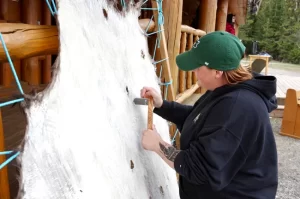Fort William First Nation hosts another successful hide tanning camp

By Rick Garrick
THUNDER BAY — The 6th Annual Fort William First Nation Hide Tanning Camp, held May 7-11 on the shores of Lake Superior at Thunder Bay’s Chippewa Park, was a success with knowledge shared by participants from Minnesota, B.C., and other communities.
“It’s beautiful and such a wonderful opportunity to bring so many people together from all over the place,” says Fort William Chief Michele Solomon. “We have visitors here from B.C., we have visitors here from other communities, and they come and share their knowledge, and they will leave with knowledge when they go home. It’s really a beautiful place to come and learn and be in ceremony and community with people.”
Fort William Councillor Bess Legarde enjoyed the opportunity to scrape a hide during the cool weather conditions on May 9 at the hide camp.
“You get really warm while you’re scraping, so that’s really nice,” Legarde says. “It’s not too cold today, as long as [the hide] is dry and the tension is tight. [The hide camp] is about reclaiming our traditional ways, preserving our culture.”
Jeff Harper, a participant from Leech Lake Reservation in Minnesota, says this was the third time he attended the hide camp to learn more about taking care of moose skins and helping out with the deer skins.
“I learned from one of our Elders back home about 25 years ago how to do deer skins and it’s fun,” Harper says. “It’s a good way to pull our communities back together and build and grow and learn together.”
Harper says he helped to pull a frozen moose skin apart and started to work on the deer skins on May 8.
“We were scraping yesterday (May 8) and then working the brains into them and stretching them and pulling them, getting ready for wringing them out and sewing up the holes,” Harper says. “Tomorrow we’ll be putting them in frames to work them until they are dry and hopefully smoking them on Sunday.”
Charlotte Marten, a Kitchenuhmaykoosib Inninuwug citizen who did an Anishinaabemowin puppet show at last year’s hide camp, says she did a bingo in Anishinaabemowin this year on May 9.
“Our goal here at the hide camp is to introduce the language and also to revitalize the language, and we do that by engaging people in activity,” Marten says. “We use all kinds of words pertaining to the hide camp in the way we played the bingo. And today (May 10), the language for charades was really a lot of fun.”
Mary Magiskan, a hide tanning mentor and Aroland citizen, says they worked on a moose hide on May 9.
“We’re taking all the flesh and all the fur off so that we can stretch it on a frame,” Magiskan says. “Once it’s dry, we can scrape the membrane off and then it will be ready to soften and to introduce the brains so that we can turn it into leather. When everybody comes around and gets their hands on the hides, it makes it a lot easier, so it’s definitely community work.”
Betty Carpick, an Indigenous artist from Thunder Bay, says she did a community project for all ages and abilities at the hide camp.
“We have circles made of unsmoked hide, which is white; home-tanned hide, which is the process we’re working on over this hide camp; and then commercial or factory-tanned hide,” Carpick says. “So each [different hide] responds to the needle in different ways. I’ve got bead soup of little tiny seed beads and then some bigger beads representing the seven teachings, and folks, based on their own abilities, are just learning how to do a little bit of simple and playful stitching.”
Hailey MacLaurin, program planner at the hide camp, says they were overjoyed about being able to hold the hide camp on the shores of Lake Superior.
“This feels like where it’s supposed to be,” MacLaurin says. “It’s very inviting, it feels more communal, it’s beautiful, it’s perfect here.”
MacLaurin says one of the highlights of the hide camp was the traditional foods.
“I’m very involved with our community garden and the food system, so it’s very exciting to see all the traditional meat getting cooked,” MacLaurin says. “Everyone is trying it, which is amazing. [They’re] smoking fish today and moose meat, we had two geese cooked, partridge soup, we had different kinds of smelts, moose meat, fish, wild rice — manomin.”


